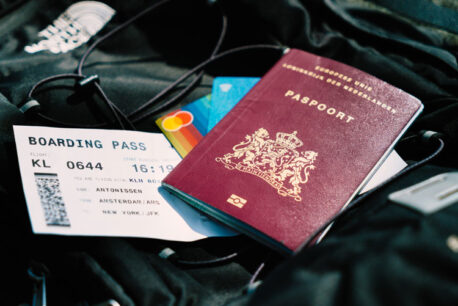Can Americans Travel To Europe?
Can Americans Travel To Europe?
This post may have affiliate links, which means we may receive a small commission (at no extra cost to you!) if you choose to purchase through them. Here’s our Disclosure & Privacy Policy for more info.
Share The Article
Last Updated 2 years ago
While U.S. travelers have been locked out of many parts of Europe for months, there have been select countries allowing Americans to visit. If you’re wondering if tourists from the United States can travel to Europe, you’re definitely not alone.
Different travel restrictions for the EU, Schengen and the UK make traveling overseas seem like you need a University Degree in immigration just to understand the rules.
At Travel Off Path, we are going to make heading to Europe a whole lot easier for you. Without the fluff and all the fancy words we’re going to let you know which countries actually allow U.S. travelers and what you’ll need to do to enter to the select few countries in Europe that are accepting American tourists.

First things first, Europe is huge and has different zones, memberships, unions and lots of things to confuse everyone. When we say Europe we mean ALL of it.
If the European country you’re looking for isn’t listed below, it’s not open to American travelers.
At the bottom we include a bonus European country for the savvy traveler.

Can Americans Travel To Europe?
While the majority of Europe is closed to U.S. travelers because the travel ban for US residents entering the European Union is still in effect, there are select European countries are accepting American tourists.
Below are all the countries in Europe that are open for American travelers.
Albania

Americans can currently travel to Albania in Southeast Europe without any restrictions.
There are no testing requirements or quarantines upon arrival.
Armenia

Armenia is located in the mountainous Caucasus region between Asia and Europe and is open to American travelers.
Travelers will have to quarantine for 14 days unless they order the mobile PCR testing which can release them from quarantine by day 4.
Belarus

Americans can travel to Belarus which is a small landlocked nation in Eastern Europe.
There are no quarantines and a PCR test is recommended.
Bosnia and Herzegovina

Bosnia and Herzegovina is a country on the Balkan Peninsula in southeastern Europe and is currently accepting United States Travelers.
All passengers must bring a negative PCR test no older than 48 hours prior to departure.
Croatia

The only member of the European Union on the list is Croatia! Americans can travel to Croatia which is a country at the crossroads of Central and Southeast Europe on the Adriatic Sea.
American travelers must present a negative COVID-19 test and fill out an online form before traveling to Croatia.
Kosovo

Kosovo, officially the Republic of Kosovo is located in Southeastern Europe and currently open to American tourists.
Montenegro

Americans can travel to Montenegro which is a Balkan country in Southeastern Europe.
Montenegro lifted the quarantine restriction American travelers and is only requiring a 72 hour PCR test.
North Macedonia

Americans can travel to North Macedonia which is a Balkan country in Southeastern Europe.
There are no testing or quarantine requirements for American tourists.
Serbia

Americans can travel to Serbia which is an European nation that borders Montenegro, Hungary, Bulgaria and Romania.
Serbia has no testing or quarantine requirements for American travelers.
Turkey

A small portion of Turkey (3%) is located in the Balkan Peninsula and is still considered Southeast Europe and is open to United States citizens.
There are no mandatory testing or quarantines for American travelers visiting Turkey.
United Kingdom

While the UK is not encouraging tourism, travelers from the United States can travel to the United Kingdom.
All U.S. travelers will face a mandatory 14 day quarantine upon arrival.
Ukraine

Americans can travel to the Ukraine which is situated in the central part of Eastern Europe.
US residents will have to bring a negative PCR test no older than 48 hours to bypass strict entry requirements.
BONUS

For American expert travelers looking to travel to Italy there may be a way to get there if you have extra time and patience.
“Can I Enter ‘x’ EU/Schengen Country After Spending 14-days in Croatia or the UK?”
We get asked this question daily. The answer is = maybe
Currently, there is a travel ban for residents of the USA into countries that belong to the European Union.
SOME EU nations (like Italy and Malta for example) have been very transparent that US residents may enter, as long as they have spent the last 14-days in a ‘safe’ nation, like Croatia.
Most other EU nations will not publicly state if they will allow US residents in after they spend 14-days in a safe nation. Mostly because, they base their travel bans on ‘RESIDENCY + LOCATION’, meaning they want visitors to be a RESIDENT of a safe country, and currently LOCATED for the past 14 days in a safe country.
If you are a US resident and you want to enter EU nations like Germany, Portugal, France, Spain, etc… you will need to contact the consulate and/or border police to find out if first spending 14-days in a safe nation will then allow you to enter.
Healthcare for U.S. Citizens When Traveling in Europe

According to the U.S. National Travel and Tourism Office, in 2016, nearly 12 million Americans traveled to Europe that year. Europe continues to be a favorite destination for many Americans, who make about 5% of international tourist arrivals. Europe draws many people for its history, architecture, gastronomy, diverse cultures, and lively cities.
While travel is usually packed with excitement and curiosity, some people might worry about what could happen if they sick while on holiday in Europe. Most European countries offer high-quality medical care and a great number of doctors and nurses speak some English. Nearly all European nations have a universal health-care system and run at a national level. The systems are mostly publicly funded through taxation.
The European Union does not have a major administrative responsibility in the area of healthcare. However, the European Commission’s Directorate-General for Health and Consumers do seek to align national laws on food safety and other products.
An essential benefit of the universal healthcare is that everyone should be taken care of in an emergency or in case of sickness. Foreigners will receive proper assistance if they’re injured or get sick.

What Happens If I Get Sick While Traveling in Europe?
There are a few options available if you get sick while traveling in Europe. Depending on your symptoms or your injury, there are pharmacies that can diagnose and prescribe remedies for stomach problems, insomnia, blisters, headaches, muscle pain, cold symptoms, etc. The majority of cities have a 24-hour pharmacy. You can always check online for the nearest one to your accommodation.
For accidents or an emergency go to a hospital. The European Union’s universal emergency number is 112. If you are not experiencing an emergency but would like to see a doctor you can go to a clinic and talk to a receptionist about your issues and why you’d like to see a doctor. You will likely have to wait but will be seen by a doctor or physician.
Healthcare costs in Europe are not as extreme as they are in the United States. This is due to the set up of their system and the contributions of each member of society. With that said, it is advised that you purchase travel insurance or some sort of insurance that will cover your expenses in case you need medical attention.
If you need to pay for the attention received, you’re likely to be asked to pay out of pocket. In other cases, you might be asked to provide a billing address. Get a copy of your bill and all information given to you so that you can file a claim when you return to the U.S.
When traveling to Europe it is essential you have a valid passport. U.S. citizens can travel to European countries without applying for a visa. The EU will soon launch a travel authorization program, ETIAS, in order to screen travelers that wish to visit the Schengen Area. It is likely that from November 2023, U.S. citizens will have to enroll online to obtain an ETIAS travel authorization for Europe.
Benjamin Murphy is a freelance travel writer from Ohio, specializing in the European Union’s myriad of options for travel. After moving to the UK, he began collaborating with various media outlets, covering travel advice and entry requirements in an ever-changing tourism industry.
Related Posts

Do Americans Need a Vaccine Certificate to Travel to Europe?
The European Union has a vaccination certificate scheme. Travelers with this electronic document are able to enter the different.

EU to Implement Digital Green Pass Vaccine Certificate
A Digital Green Pass will be implemented for traveling to Europe, Ursula von der Leyden, the President of the.

COVID-19 PCR Test to Travel to Europe from the U.S.
Many EU countries now require that travelers arriving from the U.S. and other third countries are tested for coronavirus.
What You Need to Travel to Europe in 2023
With Europe now open to international visitors, many travelers are looking forward to taking their first trip in 2022. However, overseas travel is different since COVID-19, and there will be more changes to European entry requirements in the future.
This brief guide explains what you need to travel to Europe in 2022, including visas and COVID-19 documents.
Remember that entry restrictions and requirements are being updated regularly. Make sure you have all the latest information before arranging travel to Europe.

Passports and Entry Permits to Travel to Europe
Pre-pandemic, there was one key document to travel to Europe—a valid passport.
If you’re an American or Canadian citizen, you can enter the Schengen Area with just a passport and explore 26 countries for up to 90 days visa-free. This remains the same despite COVID-19. However, you’ll also need the additional COVID-19 documentation explained below.
Europe’s Entry Requirements for Americans, Canadians, and other visa-exempt countries will change
Europe’s entry requirements for Americans, Canadians, and other visa-exempt countries will change at the end of this year. You’ll soon need an electronic travel authorization called ETIAS to visit European destinations.
The exact launch date has not yet been announced. It was originally slated to go into effect in late 2022. However, the European Union has postponed the launch of the European Travel Information and Authorization System (ETIAS) to November 2023. There’ll be a short implementation period before the visa waiver becomes mandatory to travel to Europe visa-free on an American or Canadian passport.
It’s important to point out that this is not a visa. The new permit is similar to the United States ESTA, you’ll be able to register online in a few minutes. To find out if you’re eligible, check here.
Passport holders from other countries still require a Schengen visa for their vacations in Europe. Visas are also required for stays of over 90 days.
Vaccine Certificates to Travel to Europe
The European Union recommends that Member States progressively reopen to international travel. According to EU guidelines, people fully vaccinated with vaccines authorized by the European Medicines Agency (EMA) should be able to visit Europe for any purpose, including on vacation.
Although each Member State is responsible for its borders and sets its own entry restrictions, many countries follow these rules. Favorite European tourist destinations such as Spain and Italy are now open to tourists from around the world.
Vaccines approved by the EMA are Comirnaty (BioNTech and Pfizer), Nuvaxovid (Novavax), Spikevax (Modern), Vaxzevria (AstraZeneca), and COVID-19 Vaccine Janssen.
Several EU Member States also accept vaccines approved for emergency use by the World Health Organization (WHO).
Your vaccination certificate must include the type of vaccine received and the dates of each dose. Other key information includes the country where the vaccines were administered and the certificate issuing authority.
It’s important to check the specific vaccine certificate requirements for the country you want to visit. In particular, the accepted vaccines and how many days before travel you need to have received the last dose (usually 14).
Some countries accept a recovery certificate instead of proof of vaccination. A vaccine passport is required to enter some public spaces in Europe. In Spain, you’ll need to show a valid document to enter restaurants.

Passenger Locator Forms
This document goes by several names: passenger locator form, travel health certificate, electronic health declaration, etc. Many European countries now require passengers to fill out an online form before departure.
This form allows nations to screen visitors for health risks before they cross the border. It also facilitates contact tracing. You’ll typically have to provide information about your recent travel history and where you will stay during your visit. Contact information is also requested.
Travel health forms must be submitted 48 to 72 hours before arrival. Where required, you’ll need to present the QR code or pass before boarding a flight to your destination.
European countries with obligatory passenger locator forms in 2022 include Belgium, Croatia, France, Greece, Portugal, and Spain, amongst others. If you plan to visit more than one country on your trip to Europe, be aware that a different travel health certificate is required for each country.

COVID-19 Test Results to Travel to Europe
The document you may need to travel to Europe in 2022 is a COVID-19 test certificate showing a negative result.
Whether you need a COVID-19 test for Europe depends on your vaccination status and the country you are visiting. You don’t need a pre-departure test to visit countries including Latvia and Spain if you’re fully vaccinated.
If you need a test to travel you must check the type of test required (for example, PCR or antigen), and soon before departure you should take the test.
A test certificate showing the date and time of the test, the type of test carried out, and where the certificate was issued is essential.

Europe 2022 Document Checklist
To summarize the requirements explained above, here is a checklist of what you may need to travel to Europe this year:
- Valid passport
- ETIAS visa waiver (from late 2022)
- Schengen visa or another relevant visa (from non-exempt countries)
- COVID-19 vaccination certificate (or recovery document)
- Passenger locator form
- Negative COVID-19 test result
Despite the additional requirements, Europe is accessible to tourists in 2022. Just allow extra time to arrange your documents, and always double-check the latest requirements.
Go World Travel Magazine is a digital magazine for world travelers. Each week, we bring you new travel videos, articles and travel tips on destinations in more than 90 countries.
Source https://www.traveloffpath.com/can-americans-travel-to-europe/
Source https://www.etias.us/insurance-for-us-citizens-when-traveling-to-europe/
Source https://www.goworldtravel.com/what-you-need-travel-europe-2022/